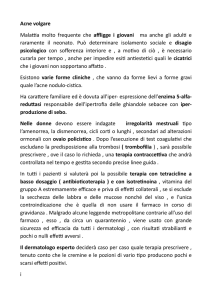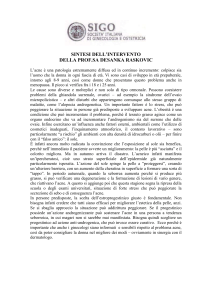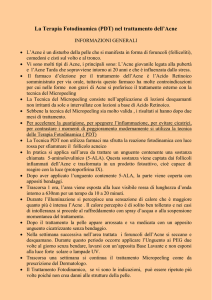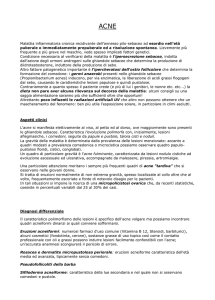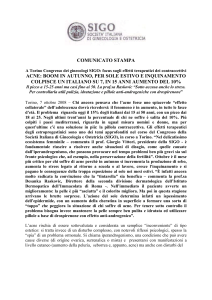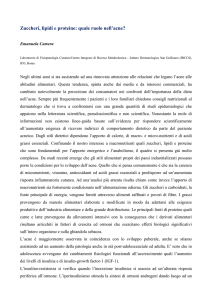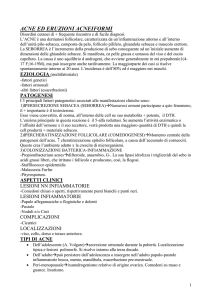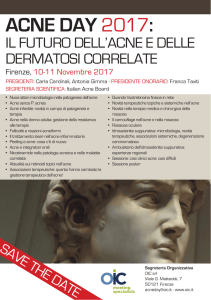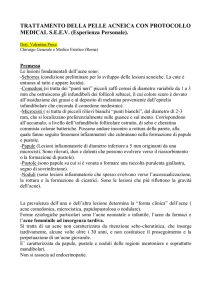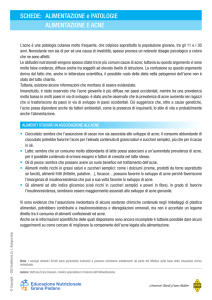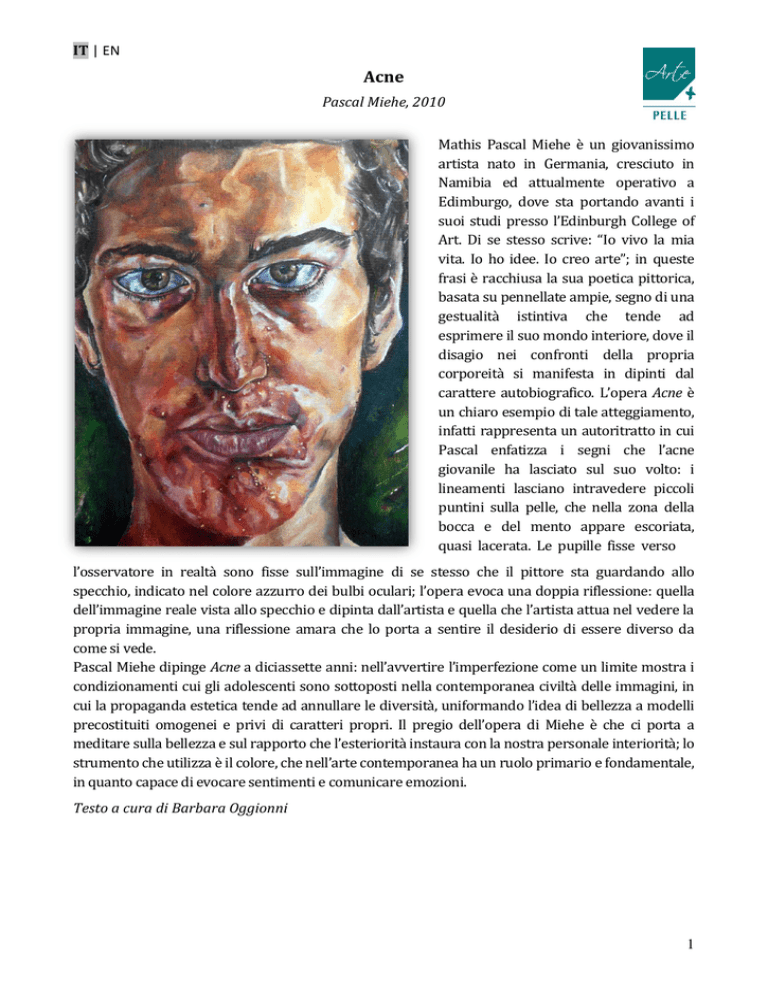
IT | EN
Acne
Pascal Miehe, 2010
Mathis Pascal Miehe è un giovanissimo
artista nato in Germania, cresciuto in
Namibia ed attualmente operativo a
Edimburgo, dove sta portando avanti i
suoi studi presso l’Edinburgh College of
Art. Di se stesso scrive: “Io vivo la mia
vita. Io ho idee. Io creo arte”; in queste
frasi è racchiusa la sua poetica pittorica,
basata su pennellate ampie, segno di una
gestualità istintiva che tende ad
esprimere il suo mondo interiore, dove il
disagio nei confronti della propria
corporeità si manifesta in dipinti dal
carattere autobiografico. L’opera Acne è
un chiaro esempio di tale atteggiamento,
infatti rappresenta un autoritratto in cui
Pascal enfatizza i segni che l’acne
giovanile ha lasciato sul suo volto: i
lineamenti lasciano intravedere piccoli
puntini sulla pelle, che nella zona della
bocca e del mento appare escoriata,
quasi lacerata. Le pupille fisse verso
l’osservatore in realtà sono fisse sull’immagine di se stesso che il pittore sta guardando allo
specchio, indicato nel colore azzurro dei bulbi oculari; l’opera evoca una doppia riflessione: quella
dell’immagine reale vista allo specchio e dipinta dall’artista e quella che l’artista attua nel vedere la
propria immagine, una riflessione amara che lo porta a sentire il desiderio di essere diverso da
come si vede.
Pascal Miehe dipinge Acne a diciassette anni: nell’avvertire l’imperfezione come un limite mostra i
condizionamenti cui gli adolescenti sono sottoposti nella contemporanea civiltà delle immagini, in
cui la propaganda estetica tende ad annullare le diversità, uniformando l’idea di bellezza a modelli
precostituiti omogenei e privi di caratteri propri. Il pregio dell’opera di Miehe è che ci porta a
meditare sulla bellezza e sul rapporto che l’esteriorità instaura con la nostra personale interiorità; lo
strumento che utilizza è il colore, che nell’arte contemporanea ha un ruolo primario e fondamentale,
in quanto capace di evocare sentimenti e comunicare emozioni.
Testo a cura di Barbara Oggionni
1
IT | EN
Herpes zoster
Il termine “acne” sembra abbia origine da un errore di
trascrizione. Attorno al 500 dopo Cristo, ad Amida in
Mesopotamia allora sotto l'Impero Romano, nasce Aezio a
cui viene riconosciuto il merito di aver scritto un grande
trattato di medicina (ben 16 libri!) in cui raccolse le opere
e i pareri dei grandi clinici prima di lui. Questo trattato fu
di riferimento, per chi si avvicinava all’arte medica, fino al
Rinascimento. Pare che i copisti di Aezio per errore
anziché AKME’ che, in greco, significava "fioritura",
trascrissero AKNE’. Il termine prese piede e rimase per
indicare la malattia della pelle caratterizzata dalla
comparsa di comedoni, papule, pustole e, talora, noduli
che chiamiamo appunto acne.
L’acne è un’affezione della pelle che può persistere per
anni se non curata. Insorge per lo più tra i 12 e i 18 anni di
età e rappresenta il principale problema estetico di molti
adolescenti. Esiste una forma tardiva, dell’età adulta, più
frequente nella donna le cui cause non sono chiaramente
definite.
L’acne origina da un’infiammazione del follicolo
pilosebaceo e dei tessuti circostanti il follicolo stesso.
Le ghiandole sebacee, nei soggetti predisposti, sotto lo
stimolo ormonale tipico della pubertà, aumentano di
volume e producono più sebo. Questo sebo in eccesso
favorisce la colonizzazione da parte di batteri e lo sviluppo
di fenomeni infiammatori che portano all’occlusione degli
sbocchi delle ghiandole sebacee e alla formazione dei
comedoni. Se poi l’occlusione permane le pareti del
follicolo occluso si dilatano fino a rompersi e
l’infiammazione aumenta. La malattia è presente nelle sedi
dove abbondano le ghiandole sebacee: viso, petto e
schiena.
Le terapie a disposizione sono molteplici. La dieta può
essere importante nel controllo dell'acne. In particolare,
una dieta che comporta un elevato indice glicemico, ad alto
contenuto di zuccheri semplici, e ricca di latticini può
portare a un aggravamento dell'acne come dimostrato in
numerosi studi e recentemente anche dal Gruppo Italiano
Studi Epidemiologici in Dermatologia (GISED).
La ghiandola sebacea coinvolta nell'acne al
microscopio ottico.
Connectivity map delle variabili esaminate nello
studio del Centro Studi GISED su acne e
alimentazione: nel petalo A1 i fattori associati
alla presenza di acne moderata-grave.
Testo a cura di Marzia Bronzoni e Luigi Naldi
2
IT | EN
Acne
Pascal Miehe, 2010
Mathis Pascal Miehe is a very young
artist who was born in Germany. He
grew up in Namibia and is currently
working in Edinburgh, where he is
continuing his studies at the Edinburgh
College of Art. He says about himself: “I
live my life. I have ideas. I create art”;
these phrases summarize his pictorial
feelings, based on ample brush strokes, a
sign of instinctive gestures that tend to
express his interior world, where his
discomfort with his body comes out in
his paintings that seem like an
autobiography. His work Acne is a
shining example of this attitude and
indeed depicts a self portrait in which
Pascal emphasizes the signs that juvenile
acne has left on his face: you can see
small spots on his skin, the area around
the mouth and chin look grazed, almost
torn. The pupils of his eyes seemed to be
fixed on the observer but they are really
fixed on himself as he is looking into a mirror while painting, which is evident by the blue colour of
the orbs; the work evokes a double consideration: that of the real image seen in the mirror and
painted by the artist and that which the artist puts into effect when looking at his image, a bitter
reflection that makes him desire to be different to whom he sees.
Pascal Miehe painted Acne when he was just seventeen: in perceiving imperfection as a limit shows
how the conditioning to which adolescents are submitted to in the contemporary culture of images,
in which the aesthetic propaganda tends to nullify diversity, rendering uniform the idea of beauty to
preconceived and homogenous models lacking any personal character. The value of the work of
Miehe is that it makes us think about beauty and the relationship that our outward appearance
establishes with our personal internal appearance; the vehicle he uses is colour, which in
contemporary art has a primary and fundamental role, because it can evoke sentiments and
communicate emotions.
Text edited by Barbara Oggionni
Translation by Gordon Frickelton
3
IT | EN
Acne
The term “acne” seems as though it came about through a
clerical error. About 500 AD in Amida in Mesopotamia,
which was then under the Roman empire, Aezio was born
and he was given credit for writing the great treatise on
medicine (16 books!) where he collected all the works and
opinions of clinicians that went before him. This treatise
was a reference piece for those taking up the medical
profession up to as late as the Renaissance. It appears that
Aezio’s copyists mistakenly transcribed the word AKME’,
which in Greek means “flowering” and re-wrote it as
AKNE’. The term caught on to indicate the name of the skin
disease typified by blackheads, papules, pimples and,
sometimes growths that today we call acne.
Acne is a skin disorder that can linger for years if not
treated. It breaks out between 12 and 18 years of age and
is the main aesthetic problem in adolescents. There is a
form that appears later in life in adults which is more
common in women but the causes have not yet been
clearly defined. Acne originates through an inflammation
of the pilosebaceous follicle and the surrounding tissue of
the follicle itself.
The sebaceous glands, in those subject to the condition,
stimulated by the hormones typical of puberty, increase in
size and produce more sebum. The excess sebum fosters
colonization by bacteria and the development of
inflammatory phenomena which lead to the blockage of
the outlet of the sebaceous gland and the formation of
blackheads. If the blockage persists the walls of the follicle
dilate until they burst and the inflammation worsens. The
illness manifests itself where there is an abundance of
sebaceous glands: on the face, chest and back.
There are several therapies available for acne. Diet can be
important for keeping a check on it. In particular, a diet
with a high glycaemic content, and a high content of plain
sugars, rich in dairy products can aggravate the condition
as has been proved by recent and numerous studies by the
Italian Group of Epidemiological Studies in Dermatology
(GISED).
The sebaceous gland involved in acne under a
light microscopy.
Connectivity map of the variables examined in
the study conducted by Centro Studi GISED
about acne and diet: in the petal A1 are
represented factors associated with the
presence of moderate to severe acne.
Text edited by Marzia Bronzoni and Luigi Naldi
Translation by Gordon Frickelton
4


